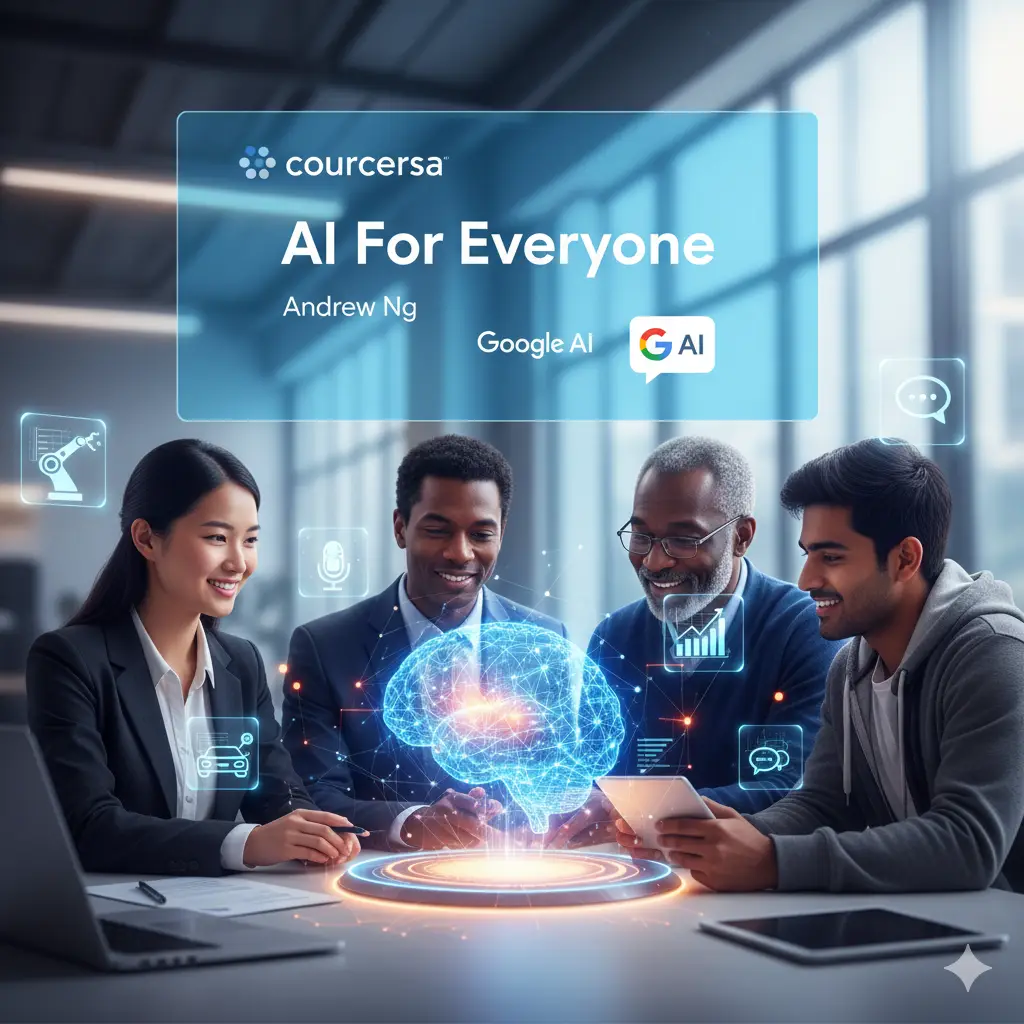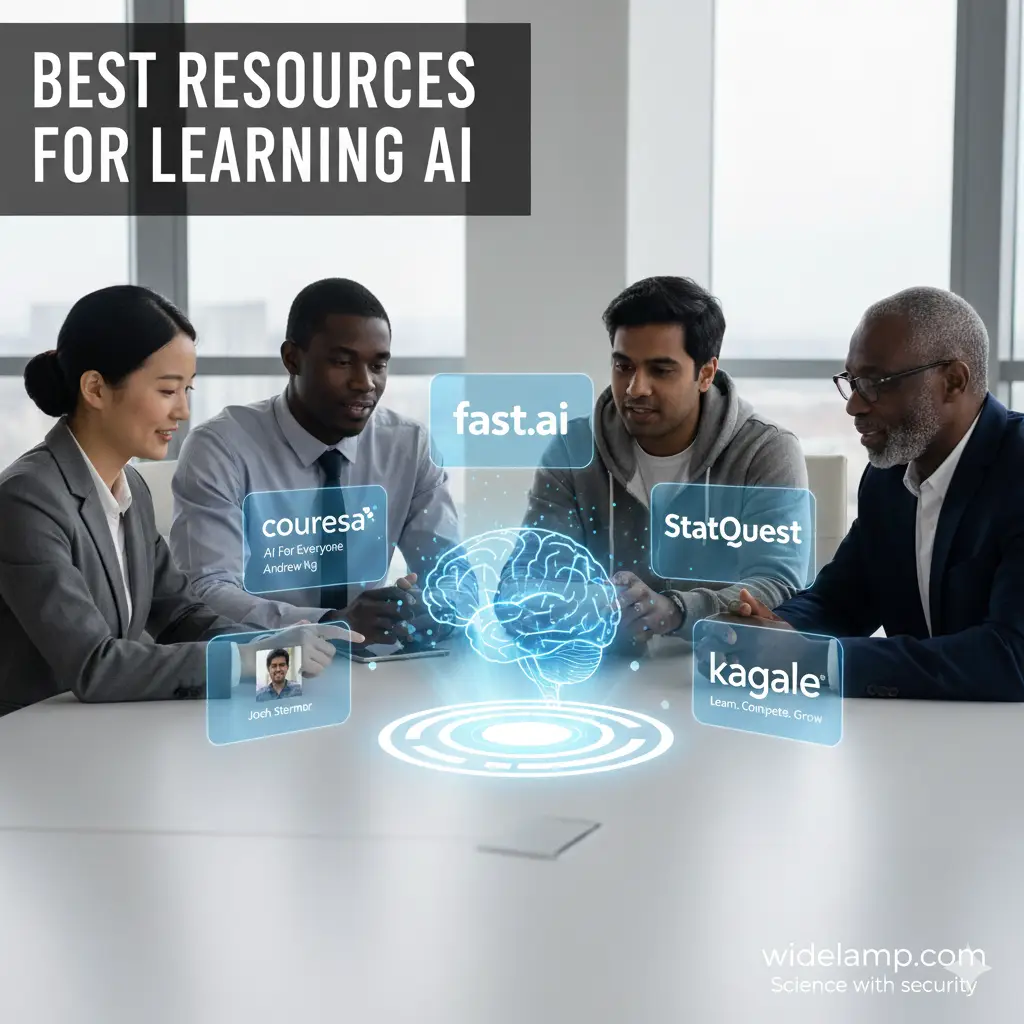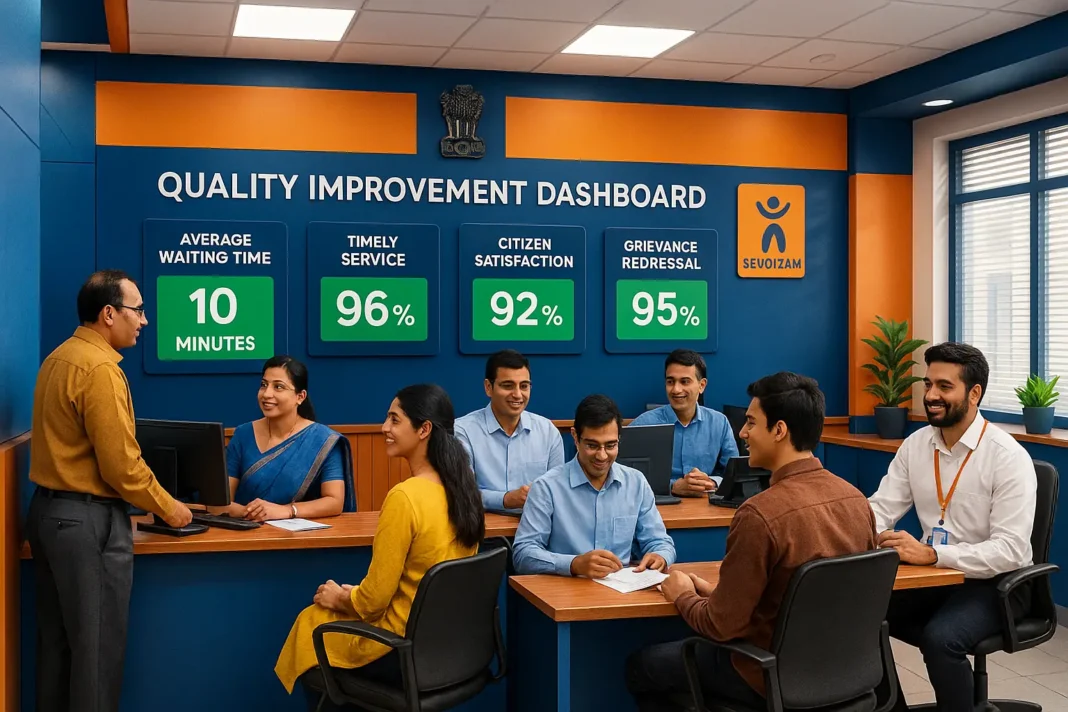|
Getting your Trinity Audio player ready...
|
The best resources for learning AI combine beginner-friendly courses, hands-on practice platforms, and modern deep learning and LLM curricula such as Google’s Machine Learning Crash Course, fast.ai’s Practical Deep Learning, MIT’s Introduction to Deep Learning, Hugging Face’s LLM course, and Kaggle Learn micro-courses for rapid skill-building and projects. Together, these cover fundamentals, practical coding, modern transformer techniques, and portfolio-ready exercises, making them a complete path from zero to building real AI applications in 2025
Table of Contents
Why Learn AI Now?
Artificial Intelligence isn’t just a buzzword; it’s a transformative technology reshaping industries, driving innovation, and creating exciting new career opportunities. From powering self-driving cars to personalizing your online experience, AI is at the heart of our modern world. Learning AI equips you with critical skills for the future, whether you aspire to be a data scientist, machine learning engineer, AI researcher, or simply want to understand the technology better.
How to start AI Learning
Start here: beginner path
- Google’s Machine Learning Crash Course is a refreshed, free, hands-on introduction covering linear/logistic regression, data handling, neural networks, LLMs, ML fairness, and production ML systems through videos, widgets, and coding exercises.
- The course was reimagined with updated content including large language models and AutoML alongside interactive learning and quizzes to make the fundamentals engaging in 2025.
- For a practical approach, fast.ai’s Practical Deep Learning for Coders teaches vision, NLP, tabular, and recommendation systems with PyTorch and popular libraries, showing how to build and deploy models quickly with accessible math and free compute options.
Deep learning and LLMs
- MIT’s Introduction to Deep Learning provides a concise program on modern deep learning with applications in NLP, vision, and biology, plus coverage of generative AI and large language models, with prerequisites limited to basic calculus and linear algebra.
- The Hugging Face LLM Course and broader Learn portal provide guided modules and resources across transformers, agents, and open-source AI skills, enabling practical work with contemporary model ecosystems.
- These curricula help bridge classical ML foundations with state-of-the-art transformer techniques and generative AI workflows relevant to today’s projects.
Hands-on practice
- Kaggle Learn offers free, bite-sized courses with certificates and curated guides so learners can gain usable skills in hours, not months, and then apply them through notebooks, datasets, and competitions.
- fast.ai pairs lessons with Jupyter notebooks and encourages using free platforms like Kaggle Notebooks for training and experimentation, reducing setup friction and enabling rapid iteration.
- This combination of guided micro-courses and real datasets accelerates confidence and portfolio building through practical exercises.
A 4–6 week study plan
- Week 1–2: Complete Google MLCC core modules on linear/logistic regression, working with data, and neural networks, then review the new LLM and fairness modules to understand today’s landscape and responsible AI.
- Week 3–4: Follow fast.ai Part 1 lessons to build and deploy a small vision or text classifier, while reading the aligned chapters of the free fast.ai book to reinforce concepts with code.
- Week 5–6: Take a targeted Hugging Face LLM module and start a Kaggle Learn track, then pick a dataset and ship a simple end-to-end project to a web demo as a portfolio artifact.
Math and prerequisites
- fast.ai emphasizes that only basic coding experience and high school math are needed, teaching necessary calculus and linear algebra in context during the course for practical progress.
- MIT’s course expects elementary calculus and linear algebra and remains beginner friendly, making it a natural next step for those who want deeper theoretical grounding after practical exposure.
Reading and references
- Deep Learning for Coders with fastai and PyTorch complements the fast.ai course, providing a code-first path with practical examples and clear explanations to reinforce model-building skills.
- Pairing this with MLCC’s interactive exercises and MIT’s conceptual modules gives both hands-on and principled understanding of modern AI.
Project ideas
- Build a small image classifier (e.g., pet breeds) or sentiment analyzer using fast.ai lesson workflows, then deploy as a simple web app to demonstrate end-to-end capability.
- Use Kaggle Learn to master a technique, pick a related dataset, and publish a reproducible notebook with clear evaluation to establish credibility for internships or junior roles.
Read More: The Impact of AI on global job market
Read More: The State of AI Security: Key Takeaways from 100 Cloud Architects, Engineers, and Security Leaders
Understanding the Landscape of AI Learning Resources
Before we jump into specific recommendations, let’s understand the types of resources available. Each caters to different learning preferences and goals:
- Online Courses (MOOCs): Massive Open Online Courses offer structured learning paths, often from top universities and institutions. They typically include video lectures, assignments, and quizzes.
- Interactive Platforms: These platforms emphasize hands-on coding and practical application, providing environments to experiment with AI algorithms.
- Books: Classic for in-depth theoretical understanding, books cover everything from foundational mathematics to advanced concepts.
- Blogs & Articles: Excellent for staying updated on the latest trends, news, and practical tutorials.
- YouTube Channels: Visual learners can benefit greatly from video explanations, tutorials, and project walkthroughs.
- Communities & Forums: Connect with other learners and experts to ask questions, share insights, and collaborate.
Now, let’s explore the best resources categorized for your learning journey!
1. For the Absolute Beginner: Your First Steps into AI
If you’re starting from scratch, these resources are designed to provide a gentle yet comprehensive introduction to AI concepts without requiring prior programming experience.
1.1. Google AI’s “A Crash Course in Causality”: This free course from Google AI offers an excellent conceptual introduction to AI and Machine Learning. It’s less about coding and more about understanding the core ideas, terminology, and implications of AI. It’s a fantastic starting point to build a strong mental model before diving into technical details.
- Why it’s great: Easy to understand, covers fundamental concepts, no prerequisites.
- External Link: Google AI Education
1.2. Coursera: “AI For Everyone” by Andrew Ng: Andrew Ng, a pioneer in AI education, offers this non-technical course designed for anyone interested in AI. It explains what AI is, what it can do, and how it’s transforming society, without getting bogged down in complex algorithms. It’s perfect for business professionals, managers, or anyone curious about AI’s impact.
- Why it’s great: Taught by an industry leader, broad overview, practical insights.
- External Link: AI For Everyone on Coursera

2. For Aspiring AI/ML Engineers: Practical Skills & Deep Dives
Once you have a grasp of the basics, it’s time to roll up your sleeves and get technical. These resources are geared towards building practical skills in programming, machine learning algorithms, and deep learning frameworks.
2.1. Coursera: “Machine Learning” by Andrew Ng: This classic course is often cited as the best starting point for anyone serious about machine learning. It covers linear regression, logistic regression, neural networks, support vector machines, and more, using Octave/MATLAB. While it uses Octave, the concepts are universally applicable to Python.
- Why it’s great: Foundational, rigorous, taught by an expert, excellent for understanding the math.
- External Link: Machine Learning by Andrew Ng on Coursera
2.2. fast.ai: Practical Deep Learning for Coders: If you prefer a “top-down” approach, fast.ai is an incredible resource. Instead of starting with theory, it dives straight into building practical deep learning models using the fastai library and PyTorch. This course is known for its effectiveness in getting learners to build real-world applications quickly.
- Why it’s great: Project-based, hands-on, uses modern frameworks, highly practical.
- External Link: fast.ai Courses
2.3. freeCodeCamp.org: freeCodeCamp offers comprehensive and free curricula on various programming topics, including machine learning with Python. Their tutorials are text-based and interactive, making them excellent for self-paced learning. Search for their “Machine Learning with Python” course.
- Why it’s great: Free, comprehensive, practical coding exercises, community support.
- External Link: freeCodeCamp Machine Learning

3. Essential Tools & Libraries: Mastering the Ecosystem
Learning AI isn’t just about algorithms; it’s also about mastering the tools that bring them to life. Python is the language of choice for AI and machine learning.
3.1. Python for Data Science: Before diving into AI, a strong grasp of Python is crucial.
- Pandas: A powerful library for data manipulation and analysis.
- NumPy: Essential for numerical computing with Python, especially for handling arrays and matrices.
- Matplotlib/Seaborn: Libraries for data visualization, helping you understand your data better.
Resources for Python:
- Codecademy: Offers interactive courses on Python fundamentals.
- Real Python: Excellent tutorials and articles for all levels.
3.2. Machine Learning Frameworks: Once you understand the algorithms, you’ll implement them using these frameworks.
- Scikit-learn: A robust and widely used library for traditional machine learning algorithms (classification, regression, clustering).
- TensorFlow (by Google): A comprehensive open-source machine learning platform, excellent for deep learning.
- PyTorch (by Facebook AI Research): Another popular deep learning framework, known for its flexibility and ease of use.

4. Books: For In-Depth Knowledge and Reference
For those who prefer a more traditional learning approach or need deep dives into specific topics, books are invaluable.
4.1. “Hands-On Machine Learning with Scikit-Learn, Keras, and TensorFlow” by Aurélien Géron: This book is a practical guide that covers machine learning fundamentals and deep learning concepts using popular Python libraries. It’s known for its clear explanations and practical code examples.
- Why it’s great: Comprehensive, practical, covers modern tools, excellent reference.
4.2. “Deep Learning” by Ian Goodfellow, Yoshua Bengio, and Aaron Courville: Often referred to as the “Deep Learning Book,” this is the definitive academic text on deep learning. It’s more mathematically rigorous and suited for those with a stronger theoretical background or who are willing to delve deep into the underlying principles.
- Why it’s great: Authoritative, comprehensive, essential for researchers and advanced practitioners.
- External Link: Deep Learning Book Online
5. YouTube Channels: Visual Learning & Project Ideas
Sometimes, seeing concepts explained visually can be incredibly helpful. YouTube is a treasure trove of AI tutorials and explanations.
5.1. sentdex: Corey Schafer’s channel offers excellent Python tutorials, including extensive series on machine learning and deep learning, often focusing on practical projects and real-world applications.
- Why it’s great: Project-focused, practical code, clear explanations.
5.2. StatQuest with Josh Starmer: For understanding the statistical and mathematical intuition behind machine learning algorithms, StatQuest is unparalleled. Josh Starmer explains complex topics in an engaging and easy-to-digest manner, often with visual aids.
- Why it’s great: Excellent for intuition, breaks down complex math, highly engaging.
6. Online Communities & Platforms: Learn, Share, Grow
Learning in isolation can be tough. Connecting with others accelerates your learning and provides support.
6.1. Kaggle: Kaggle is more than just a platform for data science competitions; it’s a massive community. You can find datasets, code notebooks (kernels) from other users, tutorials, and active discussion forums. Participating in competitions is one of the best ways to gain practical experience.
- Why it’s great: Real-world datasets, practical experience, community support, learning from others’ code.
- External Link: Kaggle
6.2. Stack Overflow / Stack Exchange: For specific programming errors or conceptual questions, Stack Overflow is an indispensable resource. Chances are, someone else has faced the same issue and found a solution.
- Why it’s great: Solutions to coding problems, expert answers, vast knowledge base.
Your AI Learning Journey: Tips for Success
- Start with the Fundamentals: Don’t rush into complex topics. Build a strong foundation in Python, linear algebra, calculus, and statistics.
- Practice, Practice, Practice: AI is a hands-on field. Work on projects, participate in Kaggle competitions, and implement algorithms from scratch.
- Stay Curious and Keep Learning: The field of AI is constantly evolving. Follow blogs, research papers, and news to stay updated.
- Join a Community: Engage with other learners and professionals. Share your progress and ask for help when needed.
- Don’t Be Afraid of Math: While some resources minimize the math, a basic understanding of linear algebra and calculus will significantly deepen your comprehension.
Conclusion
The journey into Artificial Intelligence is exciting and rewarding. With the wealth of resources available today, anyone with dedication can gain valuable AI skills. Start with what resonates with your learning style, build a solid foundation, and most importantly, keep building and experimenting. The future of AI awaits!

Q & A Section
What is the best way to start learning AI for beginners?
For absolute beginners, start with conceptual courses like Andrew Ng’s “AI For Everyone” on Coursera or Google AI’s introductory materials. These focus on understanding AI’s core ideas and impact without requiring coding. Once you grasp the concepts, move to Python fundamentals.
Do I need strong math skills to learn AI?
While you don’t need to be a math genius, a basic understanding of linear algebra, calculus, and statistics is highly beneficial for truly understanding how AI algorithms work. Many resources teach the necessary math alongside AI concepts.
Which programming language is best for AI and machine learning?
Python is overwhelmingly the most popular and recommended programming language for AI and machine learning due to its simplicity, extensive libraries (like TensorFlow, PyTorch, Scikit-learn), and large community support.
Are there free resources available for learning AI?
Yes, absolutely! Many high-quality free resources exist, including courses from freeCodeCamp, parts of Coursera and edX, YouTube channels like sentdex and StatQuest, and platforms like Kaggle for hands-on practice.
How long does it take to learn AI?
The time it takes varies widely based on your background, dedication, and desired level of expertise. You can grasp basic concepts in weeks, but becoming proficient in developing AI models might take several months to a year or more of consistent learning and practice. It’s a continuous learning journey.
What are the essential tools and libraries for machine learning in Python?
Key Python libraries include NumPy for numerical operations, Pandas for data manipulation, Matplotlib/Seaborn for visualization, and Scikit-learn, TensorFlow, or PyTorch for implementing machine learning and deep learning models.



